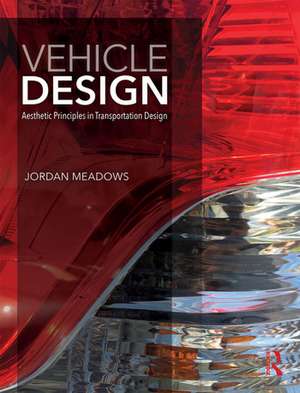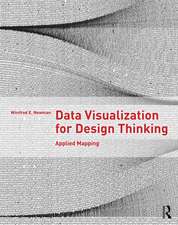Vehicle Design: Aesthetic Principles in Transportation Design
Autor Jordan Meadowsen Limba Engleză Paperback – 10 oct 2017
Preț: 389.12 lei
Nou
Puncte Express: 584
Preț estimativ în valută:
74.46€ • 77.94$ • 61.97£
74.46€ • 77.94$ • 61.97£
Carte tipărită la comandă
Livrare economică 31 martie-14 aprilie
Preluare comenzi: 021 569.72.76
Specificații
ISBN-13: 9781138685604
ISBN-10: 1138685607
Pagini: 240
Ilustrații: 27 Line drawings, color; 212 Halftones, color; 239 Illustrations, color
Dimensiuni: 189 x 246 x 17 mm
Greutate: 0.68 kg
Ediția:1
Editura: Taylor & Francis
Colecția Routledge
Locul publicării:Oxford, United Kingdom
ISBN-10: 1138685607
Pagini: 240
Ilustrații: 27 Line drawings, color; 212 Halftones, color; 239 Illustrations, color
Dimensiuni: 189 x 246 x 17 mm
Greutate: 0.68 kg
Ediția:1
Editura: Taylor & Francis
Colecția Routledge
Locul publicării:Oxford, United Kingdom
Public țintă
Professional and Professional Practice & DevelopmentCuprins
Statement of Aims. Introduction. Chapter 1: VISION. 1.1: Identifying Opportunity, Defining a Vision, Setting Targets. 1.2: Identify and Analyze Strengths and Weaknesses and Opportunities in Your Portfolio. 1.3: Research Examples of Personal Design Manifesto and Design Movements. 1.4: Identify a customer and market opportunity based on an emotional experience. 1.5: Interview with Ralph Gilles, Executive Vice President of Design, Fiat Chrysler Automobiles. CHAPTER 2: ANALYZE. 2.1: Introduction to the Idea of Narrative in Design. 2.2: Why is a Narrative Important? 2.3: How to Construct a Narrative to Establish Motivation. 2.4: Interview Angela Weltman, Ph.D. on Consumer insights. CHAPTER 3: VERBALIZE. 3.1: Understanding the interplay between Brand and Design Brief. 3.2: Creating a Design Brief. 3.3 Mazda Motorsports and Furai Concept brief (Case Study). 3.4: Interview with Robert Davis, Senior Vice President, Mazda North America and Head of Mazda Motorsports. CHAPTER 4: IDEATE. 4.1: Get Going! Staring at a Blank Page. 4.2: Explore various vehicle packages and technical solutions based around the needs of your target customer and market opportunity. 4.3: Consider the powertrain implications on basic packaging. It's physically motivating the vehicle! 4.4: Structure and a Framework for Vehicle Architecture. 4.5: Explore unique visual DNA for vehicle based on objectives established in your Design Brief. 4.6: Begin to explore surface language. 4.7: Explore details, and unique selling points and features. 4.8: Create a range of choices. 4.9: Interview with Freeman Thomas, Director Ford Advanced Design. CHAPTER 5: IMPLEMENT. 5.1: Design Strategy - a Brief Overview. 5.2: Understanding Segmentation and Competitive Benchmarking. 5.3: Magic, Risk and Balancing Science with Sorcery. 5.4: Interview with Peter Schreyer, Chief Design Officer, Kia/Hyundai. CHAPTER 6: DEVELOP. 6.1: Releasing the Wild Horse. 6.2: Character Development and Processing Imagery. 6.3: Establishing an Architectural and Visual Foundation. 6.4: The Major League: Design Development in Full-Size. CHAPTER 7: SELECT. 7.1 Creating an Initial Design Prototype. 7.2: Final Theme Selection. 7.3: The Final Cut. CHAPTER 8: SYNTHESIZE. 8.1: UX (User experience) design in overview. 8.2: Experiences in Motion: 8.3: UX for Vehicles. 8.4: Strategies and Methods for vehicle UX. 8.5 Looking Forward- Unique Opportunities. 8.6: Jeep Willys Concept: component design Case Study. CHAPTER 9: MODEL. 9.1 Virtual 3-D and the Digital Design Process. 9.2: Digital Sketch Modeling. 9.3: Three-dimensional Data Development. 9.4: Rapid Validation Mockups. 9.5: Clay Modeling: Mazda Kiora Concept Case Study. 9.6: 3-D printing, Rapid Prototyping, and Hard Model Fabrication. 9.7: Deployment strategies for Different Types of Model Making. CHAPTER 10: BUILD. 10.1: Vetting an Idea. 10.2: Engineering, Processing and Testing. 10.3: Market Research, Clinics, and Gauging Acceptance. 10.4: Early Stage Vetting for Designers. 10.4: Interview with Raj Nair, Senior Vice President of Product Development, Ford Motor Co. CHAPTER 11: LAUNCH. 11.1: Critiques, Constructive Presentations, and the Exchange of Ideas. 11.2: Presenting to Clients, Management, and Key Stakeholders. 11.3: Pitching to Prospective Users and selling new viewers on an Idea. 11.4: Interview with Moray Callum, Vice President of Design, Ford Motor Co. CHAPTER 12: EVALUATE.G 12.1: Taking Stock of Lessons Learned While Looking Ahead. 12.2: Looking Forward: Factors Changing the Future of Transportation. 12.3: Future Population Scenarios. 12.4: New and Emergent Mobility Paradigms. 12.5: Connectivity and the Internet of things. 12.6: Zero Emissions Technology. 12.7: Autonomous and Driverless Scenarios. 12.8: New Question and Key Implications for Designers. About the Author. Glossary. Bibliography.
Descriere
Vehicle Design guides readers through the methods and processes designers use to create and develop some of the most stunning vehicles on the road. Case studies from Ford, Mazda, and Jeep illustrate the production process from research to execution with more than 245 color behind-the-scenes images.










